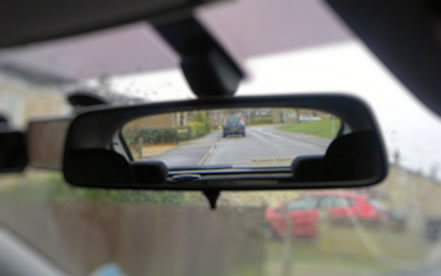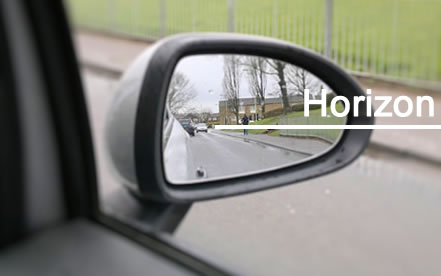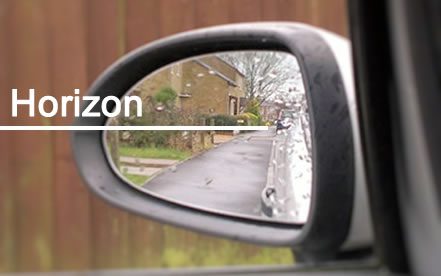How you set up and the correct mirror adjustment on your car will be explained by your driving instructor during the cockpit drill on your first driving lesson.
If you haven’t taken the time to properly set up your vehicle’s mirrors just before a driving test, the examiner may notice if the mirrors are not properly adjusted and if your observations are affected, this may impact the results of your test.
The correct adjustment of car mirrors is important in regards to safety to yourself, your passengers and other road users, but also critical for aiding you in passing the test as all-round observation is essential.
This section explains how to correctly set up and adjust your car mirrors along with tips for using your mirrors during a driving test.
How to Set Up Interior Rear View mirror
The rear view mirror is an exact representation of the distance of objects behind you as the glass is flat. Setting the interior rear view mirror should be done as follows:
- Sit in your normal driving position and using your left hand, grip the plastic surrounds of the mirror and move it so that you can see the entire rear window and as little of the interior as possible. Essentially, ‘Frame’ the rear window in the mirror.
- Be careful not to touch the glass as this will smear it and will produce glare if driving at night.

How to Set Up Side Mirrors
Setting up your car side mirrors is done by doing the following:
Right Door Mirror
- Sitting in your normal driving position, adjust the right wing mirror so that the horizon (the point at which the road disappears into the distance) is in the centre of the mirror.
- Ensure there is only a very small portion of the side of your car in the left side of the mirror. This will allow you to see more of the road behind you.
- It’s important that you adjust the mirrors in the driving position after you have adjusted the seats correctly or you will need to set the mirrors again.

Left Door Mirror
- Adjust the left wing mirror using the same technique as the right mirror, sitting in the driving position after the seats have been adjusted

Tip
Set the left mirror slightly lower than the right mirror. This will allow you to have a better view of the kerb (or curb as also known) whilst doing manoeuvres such as the reverse round a corner. Ensure you do not set the mirror too low and that you can still see clearly the end of the road.
Additional mirrors
Additional mirrors can be purchased that attach to the wing mirrors. These mirrors increase the viewing angle for what can be seen behind the vehicle. Although some of these mirrors are call blind spot mirrors, they should never replace a physical check of the blind spot. These additional mirrors can be used in the driving test and can provide a better view of the kerb when doing manoeuvres.
Wide set mirrors
Setting the mirror wide so that you cannot see any of your own vehicle in the side mirror is a method used by some individuals. This technique apparently covers the blind spots so reduces the need to physically turn your head to check the blind spot as frequently, if at all.
This method is not recommended for learner drivers or the driving test. Setting your mirrors wide can lead to the possibility of increased blind spots and regardless of how your mirrors are set or if you are using additional blind spot mirrors, it should never replace a physical check of the blind spot before changing direction. This is dangerous and will instantly fail a driving test.
Altering the mirrors during a driving test
Adjusting the mirrors correctly before driving is important for safety and before the driving test. If at any point during a driving test you decide you are not happy with how your mirrors are set, ensure you pull over in a safe and legal position and secure the car before altering them.
It is acceptable to adjust the mirrors before a manoeuvre on a driving test if it is to make the manoeuvre safer by providing better observation. Although this is acceptable, it is perhaps not advised due to a learner forgetting to re-set the mirrors when the manoeuvre has been completed. Instead, if you are struggling to see the kerb or pavement on manoeuvres, purchase a set of additional mirrors that attach to your existing wing mirrors.

Hello ,
Thank you for replying to my previous queries.
I have another issue I come across frequently.
As I glance into a sideview mirror I significantly Swerve in that direction ( more obvious on high speeds such as dual carriageways-when checking for merging traffic from slip roads or lane change).
I understand it would improve with experience, my concern is my upcoming driving practical test.
many thanks
Hi Mo,
Rather than taking one longer look into the side mirrors, make a few mirror checks but for a much shorter amount of time. So, very quick glances. This should help with preventing your swerving. It’s something you’ll need to rectify and practice before your test as it can potentially fail it.